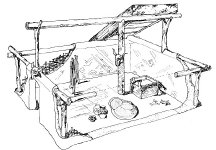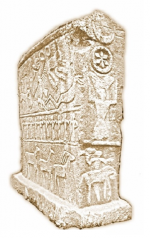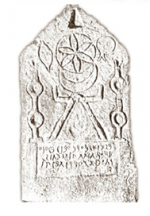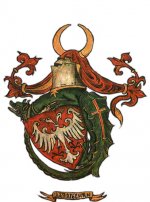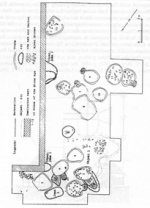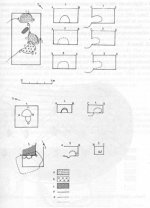Let me continue
Who are the Irish?
There is something very interesting about the Irish language. You have a lot of words which are pronounced and sometimes even spelled the same, and which have completely different unrelated meanings. This shows that Irish is a composite language. No language, which is not composite, has that characteristic. You have a lot of that in English and everyone knows that this is because English is a composite language. I believe that the same is the case with Irish. Believe or not, I bought the biggest Irish English dictionary I could find, and I read it cover to cover (mad I know). And you have this over and over again. But what you also have is lots of old words which were Gaelicised. You can see this if you compare them with the old Irish versions. Time after time you see the same pattern, where the original word was changed to confirm with the Gaelic language structure. And the last thing that I noticed is that there are many base terms, which should really be defined with one word, but which have multiple words in Irish. Again this is the sign of a composite language.
This is completely in tune with the archaeological evidence, Irish historical records and genetic data.
I read a very good book recently called "The Origins of the Irish" by J. P. Mallory.
James Patrick Mallory is an Irish-American archaeologist and Indo-Europeanist. Mallory is an emeritus professor at Queen's University, Belfast, a member of the Royal Irish Academy and the editor of the Journal of Indo-European Studies and Emania: Bulletin of the Navan Research Group (Belfast).
What does he have to say about who today's Irish are?
Basically no one knows. But what we do know is that there was definitely significant influx from both western Mediterranean and from south Baltic…
There seemed to have been two Irelands:
First one was Ireland of P(F)omorians, Tuatha de Danaan, Fir bolg, Ango Saxons, Pruteni, Vikings which was influenced from south Baltic region.
Second one was the Ireland of Gaelic, Iverni, Milesians, Mil Espain, which was influenced from western Mediterranean region.
I don’t know who the original inhabitants of Ireland were, but I know that for at least last 4500 years, there has been continuous transfer of people, cultures and languages from these two centres into Ireland. Ireland was never one country and one culture, and it still isn’t. There is a drastic difference between south west (Mediterranean) and north east (South Baltic) influenced part of Ireland. There is a drastic difference in cultures in these two parts of Ireland, starting from two different types of megalithic structures which belong to either western Mediterranean or Central European Southern Baltic types.
The Iberians were according to the Irish chronicles the last to invade Ireland. They came and they burned and they destroyed and they plunged Ireland into a dark age. Do we have any evidence if this actually happen and when? We do. In "The Origins of the Irish" J. P. Mallory says that there is a sudden change in archaeological evidence which coincides with the beginning of the Iron Age in Ireland. It coincides with a massive depopulation of Ireland and switch from agriculture to flock herding. It also coincides with massive fortification and building of huge number of ring forts. So Gaels came and brought with them the Iron Age with all its beauties. It took Ireland couple of hundred years to recover.
The fact that the Gaels were at war with the Tuatha, Fomorians and the other central European people is evident from the Irish annals, which were by the way all written by the victors of this great struggle, the Gaels. In these histories the old people (Tuatha, Fomorians, Pruteni) were portrayed as enemies, evil, devious, magicians who should not be trusted, powerful but corrupt and bad. However the kings of Tuatha, Fomorians, Pruteni are credited with bringing all the arts and crafts to Ireland, and are frequently found imbedded in genealogies of the main Gaelic ruling families. Is this an attempt of the invaders to legitimise themselves by claiming relation to the powerful and famous rulers of old? Or was there a genuine intermarrying between these two peoples? Probably both.
The relationship between the Gaels and for instance the Tuatha is also evident from the Irish language:
Tuata - Layman
Tuath - people, tribe, laity
Tuath - lay, rural
Tuath - left, sinister, perverse, evil, malign
Tuathack - king, lord, chieftain
Tutahal - directed against the sun, wrong
Tuathalach - towards left, sinister, awkward, slovenly
Surely if Tuatha were Gaels, Tuath would not have such bad connotations in today's Gaelic Irish language?
The cultural merging of these two Irelands probably started quite early. Both communities were tribal, so there was no real sense of us against them. They formed and dissolved tribal alliances which fought each other and probably consisted of clans from both peoples. Maybe not. But by the fact that they lived side by side they must have communicated, traded, intermarried (stole each other’s wives) which all contributed to language mixing. The all-out war between these two sides only started with arrival of Christianity. They supported the south of Ireland, which turned out be mostly Gaelic, Milesian, Mil Espain side, and they eventually took over most of Ireland and forced their culture and language on everyone else apart from the eastern part of Ireland where thanks to continuous migration from south Baltic we have a continuation of this non Gaelic culture which morphed into Viking and later into Anglo Irish culture.
George Eogan is an Irish Archaeologist with particular interest in the Neolithic and Late Bronze Ages. A first degree at University College Dublin was followed by a doctoral thesis on Irish Late Bronze Age swords at Trinity College Dublin under Frank Mitchell. In the 1950's he worked with P.J. Hartnett on the Neolithic passage tomb at Fourknocks, and with Sean O Riordain at the Mound of the Hostages on the Hill of Tara. He was the Director of the Knowth Research Project and excavated at Knowth for more than 40 years as part of his investigation of the Passage Tomb builders in Ireland and Western Europe. Professor Eogan is a native of Nobber, Co. Meath in Ireland and has taught and lectured extensively on Irish archaeology.
Recently he gave this interview to the Irish Times newspaper, after spending his whole life studying the old kingdom of Brega and Bru na Boinne:
http://www.irishtimes.com/life-and-style/people/eoin-butler-s-q-a-1.1066834
Here is one excerpt:
The point is, that we don’t know who the people were who lived in Brega kingdom in the period 7 - 12 century AD. We know they were different from today’s Irish and had strange names and probably even spoke a non-Gaelic language, but we just don’t know.
If potentially non-Gaelic people had their kingdoms in medieval Ireland, then it is almost certain that they did control even bigger portions of Ireland in more distant past. This is evident from another very good book which I read recently. The book is called “Iverni: A Prehistory of Cork”.
The book is written by Professor William O'Brien. Professor William O'Brien is a graduate of University College Cork where he completed doctoral research in 1987 on the subject of prehistoric copper mining. Prior to his appointment to the Cork chair in 2006, he lectured for 16 years in the Department of Archaeology, NUI Galway. His research interests include the Chalcolithic and Bronze Age in Ireland, early mining and metallurgy in Atlantic Europe, upland archaeology, the study of hillforts and all aspects of monumentality in the later prehistoric period. He has a particular interest in the prehistory of south-west Ireland, where he has conducted numerous research excavations. He has published widely on these topics, including books on his investigation of the Mount Gabriel mines, on wedge tomb landscapes, on his discovery of the Beaker copper mine at Ross Island, Co. Kerry, on early settlement landscapes and upland farming in the Beara Peninsula, and more recently the first general study of the prehistory of the Cork region.
In his book he concludes that there was a definite border and a division between the Ivernian civilization and the rest of Ireland. This border is marked by disappearance of west Mediterranean type megaliths and appearance of Central European type megaliths. In my opinion this pretty much corresponds to the division between the Gaelic and non-Gaelic Ireland. So what was the effect of this cultural division?
I believe that it is this cultural division of Ireland that leads to the situation where not all of the Irish language conforms to the Irish grammar. For instance Irish grammar says that when making compound words, you should always put adjectives after nouns. However there are lots of names in Ireland that do not confirm to that. Place names such as Dubh Linn ("black pool" = Dublin) and Leixlip ("salmon leap") were attributed to the Norse settlers who learned Irish had trouble with putting adjectives after nouns, so they often put them before the noun. This is exactly what happens when you force the new language on subjected population. They pick up the words but keep their own grammar. But this “non Gaelic Irish” language is present in all the old Irish texts, which shows that it predates the Norse, or more precisely the Dano-Slavs, as there were no Norse settlers in the Pale of Ireland only south Baltic ones. For instance Táin Bó Cúailnge, is filled with epithets like finnbennach "white-horned", dóeltenga "beetle-tongued", echbél "horse-lipped", rúadruca "red-blushing", and the like. I know that it wasn't written down until after the Vikings invaded but (a) the original core is thought to be much older and (b) there's precious little else in the work that could be ascribed to Norse influence. Moreover, we find this sort of composition in the earliest attestations of every Indo-European language, even if it later becomes obsolete. (Latin is an excellent example of this.) So I think you might be able to say that these sorts of compounds increased in areas of Norse influence (that's certainly the case in the North of France, for instance), but it's definitely an exaggeration to say that they originate with the Northmen. I however suspect that this could have something to do with the Central and North European influence which arrived to Ireland via south Baltic with of P(F)omorians, Tuatha de Danaan, Fir bolg, Ango Saxons, Pruteni, Vikings .
It seems that these south Baltic people have been living in Ireland and Scotland from at least 4th century AD (the earliest "Viking" type houses were dated from that period, and the latest finds on the crannog in ulster are pushing this to the 2nd century ad). The artefacts and houses are of distinct south Baltic type and not the Norse type. But this influx of central European culture is much older and dates to at least 2500 bc, if we judge by the amber beads discovered in north Cork. And even older if we judge it by the age of central European type stone age structure which first appeared in Central Europe, then in the Baltic and then in Ireland.
For instance, in Ireland you have names like RuaRi which uses word Rua for Red which is very close to Germano Slavic rud, rus and rua and not gaelic derg. In this name you also have adjective before the noun. This might be strange if you believe that all Irish were Gaels. But now that we know that they were not, it becomes something that you would expect to find.
Interestingly enough most toponymes and hydronymes of Celtic origin in central Europe have adjective before the noun. Here are some examples:
Gaelic word for “big” is Mór. (Pronounced as the English word more)
Gaelic word for “river” is Abhainn . (Pronounced “awon” similar to the English word award). Proto celtic word is awa.
In central Europe there are numerous rivers called Morava.
Morava = mor + ava = Mór Abhainn = Mor Awa= big river
Morava is the biggest river in Serbia and also in Czech republic. These rivers gave the name to the territory upper and lower Moravia .
http://en.wikipedia.org/wiki/Great_Morava
http://en.wikipedia.org/wiki/Morava_(river)
Today in eastern Serbia Vlasi (Vlahi) say “mare” for big. Celts called themselves “Valahi”…
In Ireland there is a river named The Avonmore River (Irish: Abhainn Mór, meaning "big river") which is the same as Mor Ava just using Gaelic grammar.
http://en.wikipedia.org/wiki/River_Avonmore
Belgrade was in the distant past called Singi Dun. In Ireland most town names have word “dun” at the beginning like dun laoghaire.
All of this is very interesting, and forces us, I believe, to make a decision who is a Celt and who is a Gael. I believe from everything I have discovered so far that Gaels were not Celts and that Gaelic language is not a Celtic language. I believe that today’s Irish language has a lot of central European Celtic characteristics, but that they did not come from Gaelic, but from the languages of the Tuatha, Fomorians, Pruteni. This is why we have the same words and grammar in continental Europe, but only the words in Ireland.
So who are today the real carriers of Celtic language and Culture: Atlantic Bretons, Germanic and West Slavic nations of central Europe, or Gaelic people in Britain? I believe that it is a tossup…
Who are the Irish?
There is something very interesting about the Irish language. You have a lot of words which are pronounced and sometimes even spelled the same, and which have completely different unrelated meanings. This shows that Irish is a composite language. No language, which is not composite, has that characteristic. You have a lot of that in English and everyone knows that this is because English is a composite language. I believe that the same is the case with Irish. Believe or not, I bought the biggest Irish English dictionary I could find, and I read it cover to cover (mad I know). And you have this over and over again. But what you also have is lots of old words which were Gaelicised. You can see this if you compare them with the old Irish versions. Time after time you see the same pattern, where the original word was changed to confirm with the Gaelic language structure. And the last thing that I noticed is that there are many base terms, which should really be defined with one word, but which have multiple words in Irish. Again this is the sign of a composite language.
This is completely in tune with the archaeological evidence, Irish historical records and genetic data.
I read a very good book recently called "The Origins of the Irish" by J. P. Mallory.
James Patrick Mallory is an Irish-American archaeologist and Indo-Europeanist. Mallory is an emeritus professor at Queen's University, Belfast, a member of the Royal Irish Academy and the editor of the Journal of Indo-European Studies and Emania: Bulletin of the Navan Research Group (Belfast).
What does he have to say about who today's Irish are?
Basically no one knows. But what we do know is that there was definitely significant influx from both western Mediterranean and from south Baltic…
There seemed to have been two Irelands:
First one was Ireland of P(F)omorians, Tuatha de Danaan, Fir bolg, Ango Saxons, Pruteni, Vikings which was influenced from south Baltic region.
Second one was the Ireland of Gaelic, Iverni, Milesians, Mil Espain, which was influenced from western Mediterranean region.
I don’t know who the original inhabitants of Ireland were, but I know that for at least last 4500 years, there has been continuous transfer of people, cultures and languages from these two centres into Ireland. Ireland was never one country and one culture, and it still isn’t. There is a drastic difference between south west (Mediterranean) and north east (South Baltic) influenced part of Ireland. There is a drastic difference in cultures in these two parts of Ireland, starting from two different types of megalithic structures which belong to either western Mediterranean or Central European Southern Baltic types.
The Iberians were according to the Irish chronicles the last to invade Ireland. They came and they burned and they destroyed and they plunged Ireland into a dark age. Do we have any evidence if this actually happen and when? We do. In "The Origins of the Irish" J. P. Mallory says that there is a sudden change in archaeological evidence which coincides with the beginning of the Iron Age in Ireland. It coincides with a massive depopulation of Ireland and switch from agriculture to flock herding. It also coincides with massive fortification and building of huge number of ring forts. So Gaels came and brought with them the Iron Age with all its beauties. It took Ireland couple of hundred years to recover.
The fact that the Gaels were at war with the Tuatha, Fomorians and the other central European people is evident from the Irish annals, which were by the way all written by the victors of this great struggle, the Gaels. In these histories the old people (Tuatha, Fomorians, Pruteni) were portrayed as enemies, evil, devious, magicians who should not be trusted, powerful but corrupt and bad. However the kings of Tuatha, Fomorians, Pruteni are credited with bringing all the arts and crafts to Ireland, and are frequently found imbedded in genealogies of the main Gaelic ruling families. Is this an attempt of the invaders to legitimise themselves by claiming relation to the powerful and famous rulers of old? Or was there a genuine intermarrying between these two peoples? Probably both.
The relationship between the Gaels and for instance the Tuatha is also evident from the Irish language:
Tuata - Layman
Tuath - people, tribe, laity
Tuath - lay, rural
Tuath - left, sinister, perverse, evil, malign
Tuathack - king, lord, chieftain
Tutahal - directed against the sun, wrong
Tuathalach - towards left, sinister, awkward, slovenly
Surely if Tuatha were Gaels, Tuath would not have such bad connotations in today's Gaelic Irish language?
The cultural merging of these two Irelands probably started quite early. Both communities were tribal, so there was no real sense of us against them. They formed and dissolved tribal alliances which fought each other and probably consisted of clans from both peoples. Maybe not. But by the fact that they lived side by side they must have communicated, traded, intermarried (stole each other’s wives) which all contributed to language mixing. The all-out war between these two sides only started with arrival of Christianity. They supported the south of Ireland, which turned out be mostly Gaelic, Milesian, Mil Espain side, and they eventually took over most of Ireland and forced their culture and language on everyone else apart from the eastern part of Ireland where thanks to continuous migration from south Baltic we have a continuation of this non Gaelic culture which morphed into Viking and later into Anglo Irish culture.
George Eogan is an Irish Archaeologist with particular interest in the Neolithic and Late Bronze Ages. A first degree at University College Dublin was followed by a doctoral thesis on Irish Late Bronze Age swords at Trinity College Dublin under Frank Mitchell. In the 1950's he worked with P.J. Hartnett on the Neolithic passage tomb at Fourknocks, and with Sean O Riordain at the Mound of the Hostages on the Hill of Tara. He was the Director of the Knowth Research Project and excavated at Knowth for more than 40 years as part of his investigation of the Passage Tomb builders in Ireland and Western Europe. Professor Eogan is a native of Nobber, Co. Meath in Ireland and has taught and lectured extensively on Irish archaeology.
Recently he gave this interview to the Irish Times newspaper, after spending his whole life studying the old kingdom of Brega and Bru na Boinne:
http://www.irishtimes.com/life-and-style/people/eoin-butler-s-q-a-1.1066834
Here is one excerpt:
How has the site weathered the past five millennia? Were subsequent inhabitants of the area respectful of it? Did they build over it?
That’s a very interesting question. In fact, between the seventh and 12th centuries AD, the mound at Knowth was the royal residence of the kings of Northern Brega, which occupied roughly the northern half of the modern county of Meath.
When you went down there in 1962, were you the first person to enter the tomb in 5,500 years or had previous generations pottered around in there?
The kings of Northern Brega transformed the site into a protected settlement by digging two ditches. When they were digging, they discovered the entrance to the passage. Some people went in and scratched their names on the stones.
What kind of names did people have in the seventh century?
They weren’t like our names today. One name was Snedta, who was a male individual, we think.
If he was carving his name all over the place, it was definitely a man.
Yes, most likely. The other was Teistennach. They would both have been members of the Northern Brega kingdom.
The point is, that we don’t know who the people were who lived in Brega kingdom in the period 7 - 12 century AD. We know they were different from today’s Irish and had strange names and probably even spoke a non-Gaelic language, but we just don’t know.
If potentially non-Gaelic people had their kingdoms in medieval Ireland, then it is almost certain that they did control even bigger portions of Ireland in more distant past. This is evident from another very good book which I read recently. The book is called “Iverni: A Prehistory of Cork”.
The book is written by Professor William O'Brien. Professor William O'Brien is a graduate of University College Cork where he completed doctoral research in 1987 on the subject of prehistoric copper mining. Prior to his appointment to the Cork chair in 2006, he lectured for 16 years in the Department of Archaeology, NUI Galway. His research interests include the Chalcolithic and Bronze Age in Ireland, early mining and metallurgy in Atlantic Europe, upland archaeology, the study of hillforts and all aspects of monumentality in the later prehistoric period. He has a particular interest in the prehistory of south-west Ireland, where he has conducted numerous research excavations. He has published widely on these topics, including books on his investigation of the Mount Gabriel mines, on wedge tomb landscapes, on his discovery of the Beaker copper mine at Ross Island, Co. Kerry, on early settlement landscapes and upland farming in the Beara Peninsula, and more recently the first general study of the prehistory of the Cork region.
In his book he concludes that there was a definite border and a division between the Ivernian civilization and the rest of Ireland. This border is marked by disappearance of west Mediterranean type megaliths and appearance of Central European type megaliths. In my opinion this pretty much corresponds to the division between the Gaelic and non-Gaelic Ireland. So what was the effect of this cultural division?
I believe that it is this cultural division of Ireland that leads to the situation where not all of the Irish language conforms to the Irish grammar. For instance Irish grammar says that when making compound words, you should always put adjectives after nouns. However there are lots of names in Ireland that do not confirm to that. Place names such as Dubh Linn ("black pool" = Dublin) and Leixlip ("salmon leap") were attributed to the Norse settlers who learned Irish had trouble with putting adjectives after nouns, so they often put them before the noun. This is exactly what happens when you force the new language on subjected population. They pick up the words but keep their own grammar. But this “non Gaelic Irish” language is present in all the old Irish texts, which shows that it predates the Norse, or more precisely the Dano-Slavs, as there were no Norse settlers in the Pale of Ireland only south Baltic ones. For instance Táin Bó Cúailnge, is filled with epithets like finnbennach "white-horned", dóeltenga "beetle-tongued", echbél "horse-lipped", rúadruca "red-blushing", and the like. I know that it wasn't written down until after the Vikings invaded but (a) the original core is thought to be much older and (b) there's precious little else in the work that could be ascribed to Norse influence. Moreover, we find this sort of composition in the earliest attestations of every Indo-European language, even if it later becomes obsolete. (Latin is an excellent example of this.) So I think you might be able to say that these sorts of compounds increased in areas of Norse influence (that's certainly the case in the North of France, for instance), but it's definitely an exaggeration to say that they originate with the Northmen. I however suspect that this could have something to do with the Central and North European influence which arrived to Ireland via south Baltic with of P(F)omorians, Tuatha de Danaan, Fir bolg, Ango Saxons, Pruteni, Vikings .
It seems that these south Baltic people have been living in Ireland and Scotland from at least 4th century AD (the earliest "Viking" type houses were dated from that period, and the latest finds on the crannog in ulster are pushing this to the 2nd century ad). The artefacts and houses are of distinct south Baltic type and not the Norse type. But this influx of central European culture is much older and dates to at least 2500 bc, if we judge by the amber beads discovered in north Cork. And even older if we judge it by the age of central European type stone age structure which first appeared in Central Europe, then in the Baltic and then in Ireland.
For instance, in Ireland you have names like RuaRi which uses word Rua for Red which is very close to Germano Slavic rud, rus and rua and not gaelic derg. In this name you also have adjective before the noun. This might be strange if you believe that all Irish were Gaels. But now that we know that they were not, it becomes something that you would expect to find.
Interestingly enough most toponymes and hydronymes of Celtic origin in central Europe have adjective before the noun. Here are some examples:
Gaelic word for “big” is Mór. (Pronounced as the English word more)
Gaelic word for “river” is Abhainn . (Pronounced “awon” similar to the English word award). Proto celtic word is awa.
In central Europe there are numerous rivers called Morava.
Morava = mor + ava = Mór Abhainn = Mor Awa= big river
Morava is the biggest river in Serbia and also in Czech republic. These rivers gave the name to the territory upper and lower Moravia .
http://en.wikipedia.org/wiki/Great_Morava
http://en.wikipedia.org/wiki/Morava_(river)
Today in eastern Serbia Vlasi (Vlahi) say “mare” for big. Celts called themselves “Valahi”…
In Ireland there is a river named The Avonmore River (Irish: Abhainn Mór, meaning "big river") which is the same as Mor Ava just using Gaelic grammar.
http://en.wikipedia.org/wiki/River_Avonmore
Belgrade was in the distant past called Singi Dun. In Ireland most town names have word “dun” at the beginning like dun laoghaire.
All of this is very interesting, and forces us, I believe, to make a decision who is a Celt and who is a Gael. I believe from everything I have discovered so far that Gaels were not Celts and that Gaelic language is not a Celtic language. I believe that today’s Irish language has a lot of central European Celtic characteristics, but that they did not come from Gaelic, but from the languages of the Tuatha, Fomorians, Pruteni. This is why we have the same words and grammar in continental Europe, but only the words in Ireland.
So who are today the real carriers of Celtic language and Culture: Atlantic Bretons, Germanic and West Slavic nations of central Europe, or Gaelic people in Britain? I believe that it is a tossup…


